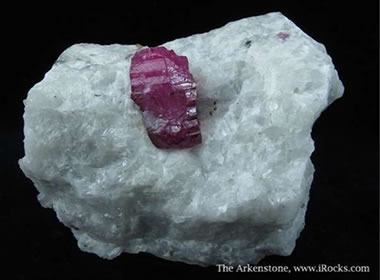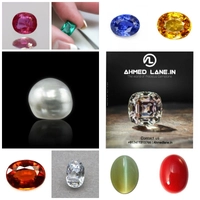Ruby and Sapphire
Ruby and Sapphire
Red corundums are rubies. Blue corundums are sapphires. Trace elements produce their colors.
Author: Hobart M. King, PhD, GIA Graduate Gemologist

Rubies: The most desired variety of corundum is the ruby. The red color is produced by trace amounts of chromium in the mineral. These two beautiful rubies were mined in Madagascar. The one on the left is a 7 x 5 millimeter octagon that weighs about 1.32 carats. The one on the right is an 8 x 6 millimeter oval that weighs about 1.34 carats. Although Asia has been the traditional source of gem corundum for over one thousand years, Africa is poised to become a new primary source.
ADVERTISEMENT
Ruby and Sapphire
Most people don't realize that ruby and sapphire are both gems of the mineral corundum. Both of these gemstones have the same chemical composition and the same mineral structure. Trace amounts of impurities determine if a gem corundum will be a brilliant red ruby or a beautiful blue sapphire. It is surprising that "impurities" can produce such wonderful results!
Red and blue are just two of the many colors found in gem corundums. Trace amounts of other elements can produce brilliant yellow, orange, green, and purple gems. Red corundums are known as "rubies," blue corundums are known as "sapphires," and corundums of any other color are known as "fancy sapphires." Impurities cause corundum to occur in a spectrum of colors, and when it is completely free of color-causing impurities, it is a colorless gem known as "white sapphire."
Table of Contents
Ruby and Sapphire Birthstones
Ruby and sapphire both serve as modern birthstones. Ruby is the birthstone for the month of July. Sapphire is the birthstone for the month of September. They are excellet choices for birthstones because they are well know gems and because many people love red and blue gemstones.
Ruby and sapphre are not inexpensive gems and that causes a challenge when they are used as birthstones. Many people want to give a birthstone gift to a child and hesitate to give a child a gift that is costly. Or the shopper would like to give a birthstone gift, but has a limited budget. To accommodate these shoppers, the use of synthetic birthstones in low carat gold or sterling silver mountings provides a lower cost option. Synthetic corundum and synthetic spinel are often used.
Related: Corundum: The Mineral of Ruby & Sapphire

Ruby on marble: A ruby crystal on white marble from Jegdalek, Saroby, Afghanistan. This crystal is about 1.6 centimeters in length. Specimen and photo by Arkenstone / www.iRocks.com.
What Makes a Ruby?
Rubies are gem corundums with a dominant red color. The color can range from orangy red to purplish red or brownish red. The most desirable color range is a pure vibrant red to a slightly purplish red.
ADVERTISEMENT
The red color of ruby is produced by the presence of chromium in the gem. A small trace of chromium will produce a pink color. To be considered a ruby, there must be enough chromium to give the gem a distinctly red color.
Finally, rubies must have a combination of color and clarity that makes them an attractive gem. Opaque pieces of corundum with just a hint of red color are not rubies - they are common corundum.
Physical Properties of Corundum | |
| Chemical Classification | Oxide |
| Color | A gem corundum with a dominant red color is a ruby. Any other color of corundum is a sapphire. |
| Streak | Colorless (harder than the streak plate) |
| Luster | Adamantine to vitreous |
| Diaphaneity | Transparent to translucent |
| Cleavage | None. Corundum does display parting perpendicular to the c-axis. |
| Mohs Hardness | 9 |
| Specific Gravity | 3.9 to 4.1 (very high for a nonmetallic mineral) |
| Diagnostic Properties | Hardness, high specific gravity, six-sided crystals sometimes tapering to a pyramid, parting, luster, conchoidal fracture |
| Chemical Composition | Al2O3 |
| Crystal System | Trigonal |
| Uses | Historically used as an abrasive. Specimens with pleasing colors have a long history of gemstone use. |
Ruby Treatments
Very few specimens of corundum have a natural color within the range required for a ruby. Very few also have the clarity required to produce a nice faceted stone. Long ago, people who prepared gem materials for cutting began experimenting with ways to improve their color and clarity.
ADVERTISEMENT
Heating
Heating corundum crystals under controlled conditions can improve or intensify their color. Heating can also remove inclusions by causing them to dissolve, making them less visible and improving the clarity of a gem.
Most rubies in the market today have been heated to improve their color and clarity. This heat treatment is normal and expected in the gem trade, but a seller should disclose the treatment to a buyer in advance of a sale.
Fracture Filling
One of the early treatments was to fill surface-reaching fractures with oils, waxes, or resins. These treatments filled pits and fractures on the surface of the gem and improved their appearance. However, these treatments are not permanent because the oils can be washed out, and the waxes and resins can crack and fall out with age - even with special care. They produce a temporary improvement in the appearance of the stone and are mainly done to produce a quick and profitable sale.
A more permanent type of fracture treatment is to fill the fractures with minor amounts of flux, glass, or another durable material. These enter the fractures during the heat treatment process. When the stone cools, a permanent filling of the fracture was accomplished. These treatments reduce the visibility of the fractures and improve the clarity of the gems. They also might improve the durability of some stones. This type of treatment is generally acceptable but should be disclosed to the buyer.
A much more aggressive treatment is to heat the gem to a very high temperature and inject glass or flux into the fractures. The temperature of this treatment can be high enough that some of the ruby melts and mixes with the fracture-filling materials. The result of this treatment is an altered stone with an improved appearance. But the stone now contains an unknown and possibly significant amount of non-ruby material. If these gems are sold “by the carat,” the buyer might pay a significant portion of the price for non-ruby material. Many people believe that these treatments produce man-made composite materials that should not be called “ruby.”

